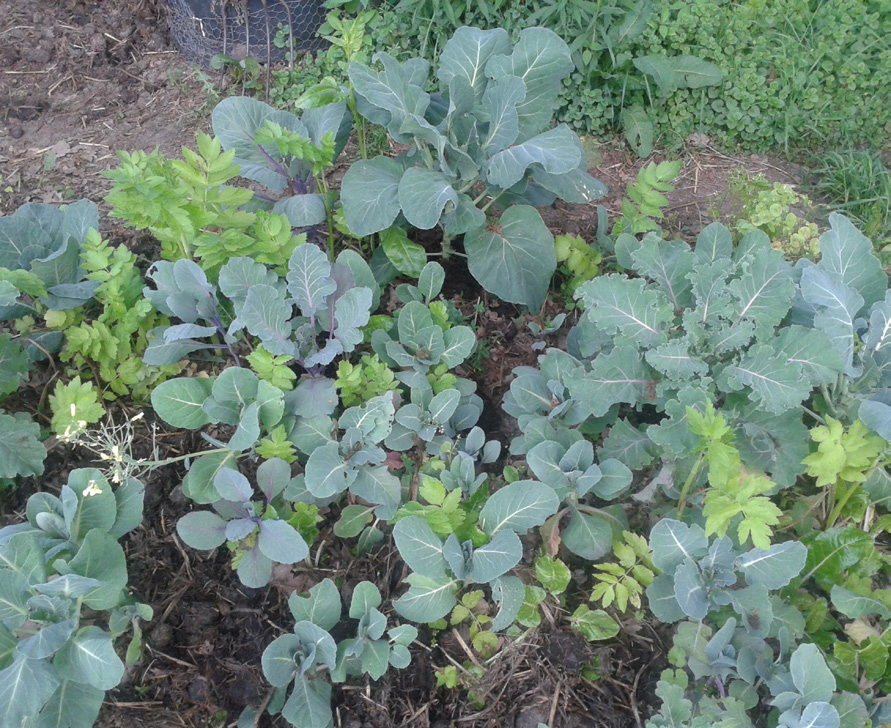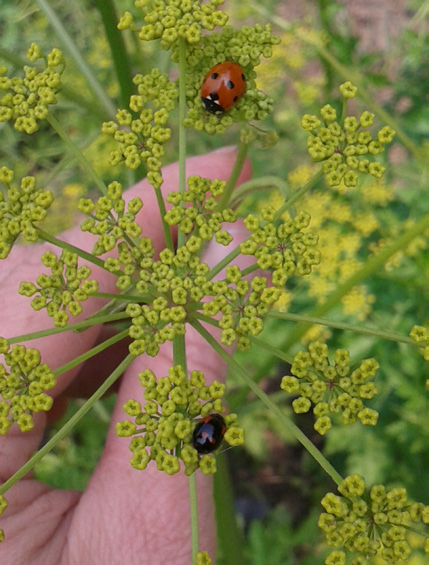
Vision of plant vitality science
25 juni 2020Translated and edited by Jitte Daalmeijer.
The future plant pathology
The opinion article by J. C. Zadoks (whom I still tend to call my professor) in the most recent edition of Gewasbescherming, the newsletter of the Royal Netherlands Society of Plant Pathology (KNPV) was the extra push I needed to write this article. It were especially the last lines of his text: “Who knows the answers to the big questions? What can change under the influence of the Corona-epidemic. I don’t know the answer.”, which increased the urge to write this article to such an extend that it is now in front of you.
To be clear, I don’t have a monopoly on wisdom! On the contrary, the answers will have to come from all of us together. For this too goes: diversity is key. When answering the big questions, all input is of worth. Everyone plays their own role in the process that leads us from the present to the future. From my point of view our future looks promising. In this article I will illustrate my vision of this future.
Imagen that to begin with, we acknowledge and support the differences between children in their education. That we hold more space for being different and for different, new-age ideas and talents. Students don’t follow a standard curriculum anymore, but their own unique path. I think that everyone of us knows a child in their direct environment who is just a bit different or more sensitive and, in some ways, even ingenious (Von Dreien, 2019). If we start to embrace those talents more, we will also start to find completely new solutions to our current problems. We can trust the creativity of a whole new generation instead of being afraid of what happens when we let them go.

If plants in a garden get the chance to blossom, they naturally provide seeds. If those seeds fall to the ground, there will automatically grow plants that are better adapted to the garden. Potential diseases help to select the most suitable plants for the environment. Photo credits: Kitty de Jager
Imagen, that with this creativity and the use of those new talents we have a closer look at the plant. In the future we will be able to see, feel and even measure, not only the outer, but also the inner (invisible) traits of plants (Strube & Stolz, 2009). This way we can make even better use of her potential. Since the better the inner quality of the food we eat, the healthier we will be and the less we will depend on the healthcare system. There currently are already people who are able to select plants that are beneficial for the wellbeing of a certain person (Lips, 2020; Mouws, 2020). The explanation for how this is possible is explained clearly in the book “The universe loves a happy ending” by Hans Andeweg (Andeweg, 2016). Zooming in on the inner quality of a plant is a big development and at the same time it is not an unusual one. It is comparable to for example, the discovery of the microscope and subsequently the electrons-microscope. Every time it turns out that there’s much more to perceive than we thought. Nature always proves to be much more complex and ingenious than we think possible.
Utilizing the full potential of a plant is possible if we’re also going to see the needs of the plant and all life around it. An obvious example is that she needs a healthy soil to grow well (van Os, 2019 en Brussaard et al, 2016). Mark Shepard wrote a wonderful book which can be of guidance when caring well for the earth. He describes how we can combine good care for the earth with the care for plenty of food (Shepard, 2014). He explains in a lot of detail how an ecologically diverse, multiannual polyculture can have a higher yield in total per hectare than a field of corn. Because of the diversity (of also trees and animals) in such a polyculture, more CO2 is stored, the soil is healthier, there is less washout and there are less plant diseases. The natural balance of the soil and the environment are restored. Additionally, he says: “such a system can last thousands of years while being managed without the input of any fossil fuels (if you want that)”. It is remarking that Justus von Liebig (1800-1873), the inventor of (artificial) fertilizer, already withdrew his earlier believes at an age of 38. He saw that by using fertilizer we would eventually exploit the soil. At that moment he realised the importance of a more holistic approach in which we can live off the interest of the land instead of off the capital (Knol & Nicola, 2011). The movie “The biggest little farm” by John and Molly Chester is a recent example of how you can completely restore an exhausted landscape in just a few years (Chester, 2018). There is hope!
Suppose that we’re going to see diseases as a signal to take even better care of the plant and her environment. We invest our energy in looking for what she needs. Think of the right nutrition, soil structure, water quality, peace at the farm and diversity of plants, animals and minerals etc. We are focused on the vitality of the plant and not on fighting diseases. Instead of fighting against, we are going to work together with nature. A balance is formed in which the system’s own regenerative power is activated. Hence, I propose a name change: from plant pathology to plant vitality science. We are going to work holistic instead of reductionistic. Everyone contributes their own bit, we are doing it together (researchers, plant breeders, farmers, traders and consumers).

Besides, there are many useful insects who enjoy all those blossoming plants. We are doing it all together. Photo credits: Kitty de Jager
Imagen that breeders, with the help of markers and through traditional breeding could develop a kind of “mixed-variety”. Such a “mixed-variety” could for example be partly uniform (in yield moment, growth speed and shape of the plant etc.) and partly variable (in disease resistance and color). Pathogens will spread much slower and the crop will be healthier in general because of the bigger variety in plants. Through the diversity of plants, the soil life will also be more diverse and consequently healthier, especially when compared to a field filled with genetically identical plants. This may seem a tiny step in comparison with Mark Shepard’s multiannual polyculture.
However, every little step in the right direction is important. With trust and patience, we grow towards something incredibly beautiful!
Imagen that not only professional breeders but also farmers and gardeners are allowed to contribute to increasing the variety in available seeds. A bigger diversity of seeds becomes available that can also be further selected and multiplied by farmers themselves (Mooney, 1979). That would be great, since every location, farmer and variety is unique (De Jager &Buizer, 2012). Because the farmer selects them himself, the plants become more and more adjusted to the local environment. This increases the suitability of the food for the local population and therefore their health. A bigger focus on the local market has many advantages in other areas too, such as working opportunities, biodiversity, well-being, the environment and the climate.
Out of fear for diseases we invest time and energy in fighting them. Let’s focus our attention on preventing them instead. We can do this by taking care of our own vitality and that of plants, animals and our entire environment. The corona-epidemic has, among other things, caused us to become aware of our focus on fear. The entire day the media was warning for danger. It is beautiful that a lot of people become aware of this at the same time. In his video message, the journalist Charles Groenhuijsen talks about the general journalistic focus on the negative and his personal choice for optimism. He regards it as our job to make the world better (Groenhuijsen, 2020). In a personal message princess Irene recently said: “the feeling of fear is overpowering” and “lets transform fear into love” (Van Lippe-Biesterfeld, 2020). It can be different. Imagen, what the world will look like if the majority of humanity focusses on living out of love and trust. Dreaming is allowed!
In the process of increasing awareness, the realisation of interconnectedness grows. If, knowing that everything is connected, we are going to live in trust, there will be less need for rules and boundaries. All problems will turn out to be collective problems, which asks for solutions that we support and carry together. I can already picture it. We are doing it together and everyone has their own unique input. An ode to you for every single step you take towards this beautiful vision of the future! Thank you very much for your attention.
This article is a slightly adjusted version of the article “visioen van plantenvitaleitskunde, plantenziektekunde in de toekomst”, which appeared in the KNPV newsletter: Gewasbescherming nr. 3, edition 51, June 2020, p. 102-104
Dr. Ir. Kitty de Jager is owner of plant vitality advise (previously plant pathology advise). She has many years of experience in disease resistance breeding of different crops (vegetables, flowers, potting plants and green manures). In recent years she has more focused on a holistic approach of biological (resistance) breeding and plant vitality. E-mail: kcmdejager@gmail.com.
References
Andeweg H., 2016. The Universe Loves a Happy EndingBecoming Energy Guardians and ECO-Healers for the Planet, Organizations, and Ourselves. Hunter House Inc. U.S., 320pp.
Brussaard L., Govers F. & Buiter R., 2016. Cahier 3, 35e jaargang. De basis onder ons bestaan, Leve(n)de bodem. Stichting Biowetenschappen en Maatschappij, Den Haag, Nederland, 88pp.
Chester J., 2018. The biggest little farm. https://www.imdb.com/title/tt8969332/
Groenhuijsen C., 2020. https://m.facebook.com/story.php?story_fbid=3662486643765921&id=1025396600808285
De Jager K.C.M. & Buizer B., 2012. https://organicseeds.nl/images/Report-survey-and-workshop-B-Buizer-and-K-de-Jager-2012.pdf
Lips W., 2020. https://www.lipsgroen.nl/ontwerp/opleiding/
Mooney, P.R., 1979. Seeds of the earth, a private or public resource?. Inter Pares, Ottawa, USA, 120pp
Mouws J., 2020. http://www.naturaplants.nl/
Shepard M., 2014. Herstellende landbouw, agro-ecologie voor boeren, burgers en buitenlui. Jan van Arkel, Utrecht, Nederland, 317pp
Strube J. & Stolz P., 2009. Op zoek naar vitale voeding – biofotonen openbaren innerlijke kwaliteit. Kybalion Publishing, Soest, Nederland, 90pp
Van Lippe-Biesterfeld I., 2020. Persoonlijke boodschap van Prinses Irene van Lippe-Biesterfeld; https://www.youtube.com/watch?v= 9MG712GVKWI
Van Os G., 2019. Aeres Hogeschool Dronten, groot bodem college. https://youtube.com/watch?v=xKKZN5ySJ-c
Von Dreien B., 2019. Christina – tweeling als licht geboren. Akasha, Eeserveen, Nederland, 319pp
Knol A. & Nicola A.,2011. Justus von Liebig. De zoektocht naar kringloop landbouw. Mulder
Agro BV, Kollumerzwaag, Nederland, 62pp
Zadoks J.C., 2020. Epidemiologische overpeinzingen naar aanleiding van de huidige corona-epidemie. Gewasbescherming 2: 72-74
Header photo: sheeps sorrel in vegetable garden – Credits: Kitty de Jager



